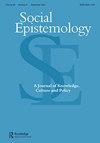非总结性社会知识的认识结构
IF 2
2区 哲学
Q1 HISTORY & PHILOSOPHY OF SCIENCE
引用次数: 0
摘要
群体G如何知道p是近年来社会认识论研究的热点问题。本文阐明并捍卫了一种非监督性、非总结性的群体知识:G可以知道p即使没有G知道p的成员,以及G是否知道p不当地取代的精神状态的成员G .相反,我们认为什么是G知道p是G的中心有一个认知结构适当运作符合集团action-related目的,这个结构可能包括non-agential元素,如设备保留或处理信息。我们认为,最近由Jennifer Lackey提出的对非总结性群体知识的反对实际上并没有成功地破坏这一观点,但确实有助于澄清非总结性群体知识的本质。我们对Lackey的反对意见的回应的主要结论是,群体以不同于个人的方式将他们的知识付诸行动,社会认识论学者应该小心注意这些差异,特别是在群体经常通过使用各种与认识论相关的手段来构建自己的情况下。本文章由计算机程序翻译,如有差异,请以英文原文为准。
Epistemic Structure in Non-Summative Social Knowledge
ABSTRACT How a group G can know that p has been the subject of much investigation in social epistemology in recent years. This paper clarifies and defends a form of non-supervenient, non-summative group knowledge: G can know that p even if none of the members of G knows that p, and whether or not G knows that p does not locally supervene on the mental states of the members of G. Instead, we argue that what is central to G knowing that p is whether G has an epistemic structure that is functioning appropriately in accord with the action-related purposes of the group, and this structure may include non-agential elements such as devices that retain or process information. We argue that recent objections to non-summative group knowledge given by Jennifer Lackey do not in fact succeed in undermining the view, but do help to clarify the nature of non-summative group knowledge. The main upshot of our response to Lackey’s objections is that groups put their knowledge into action in ways that often differ from how individuals do, and social epistemologists should be careful to notice these differences, especially insofar as groups often structure themselves by employing various epistemically-relevant devices.
求助全文
通过发布文献求助,成功后即可免费获取论文全文。
去求助
来源期刊

Social Epistemology
Multiple-
CiteScore
2.60
自引率
17.60%
发文量
60
期刊介绍:
Social Epistemology provides a forum for philosophical and social scientific enquiry that incorporates the work of scholars from a variety of disciplines who share a concern with the production, assessment and validation of knowledge. The journal covers both empirical research into the origination and transmission of knowledge and normative considerations which arise as such research is implemented, serving as a guide for directing contemporary knowledge enterprises. Social Epistemology publishes "exchanges" which are the collective product of several contributors and take the form of critical syntheses, open peer commentaries interviews, applications, provocations, reviews and responses
 求助内容:
求助内容: 应助结果提醒方式:
应助结果提醒方式:


